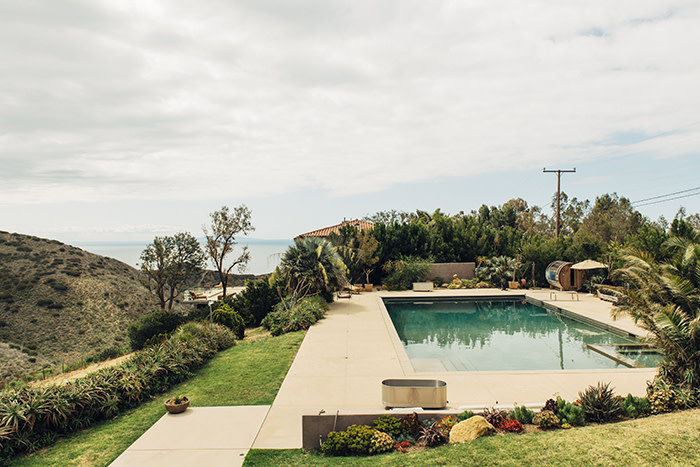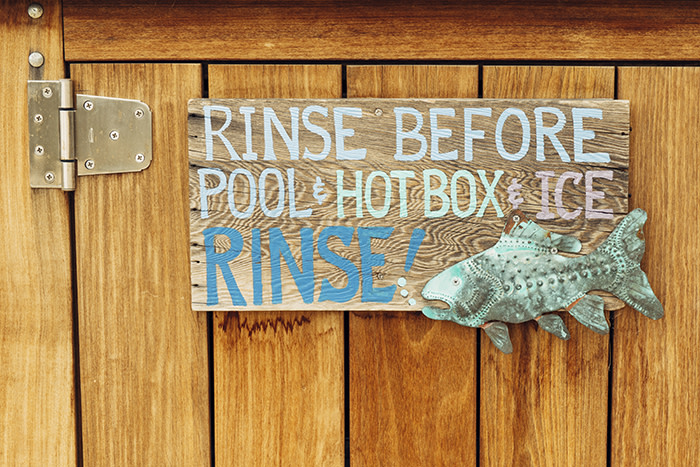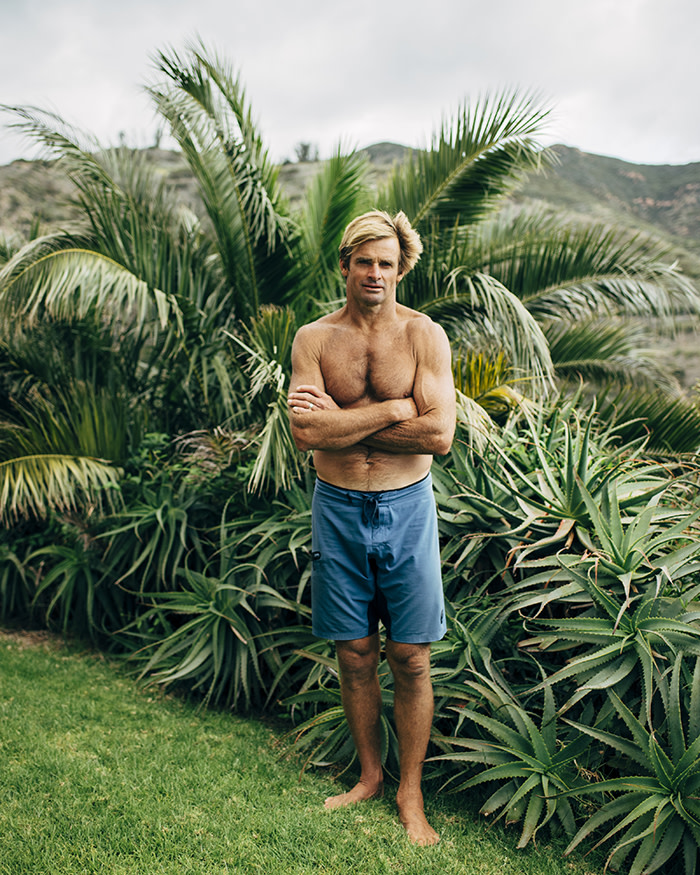New wave: how surfer Laird Hamilton makes a living from innovation
Simply sign up to the Life & Arts myFT Digest -- delivered directly to your inbox.

Twenty years ago, when surfer Laird Hamilton went to see a property high in the Malibu mountains, he stood across the street and took in the view. Down below was a rocky headland and a crisp, right-breaking wave.
“Want to take a look inside?” came a voice from the house. “I’m good,” he said. “I’ve seen what I needed to see.” He has lived there ever since, together with Gabrielle Reece, the professional volleyball player he married in 1997, and their two daughters.
That Hamilton’s California home offers a view of the ocean is little surprise. The tall, tanned figure has dedicated his life to the water — surfing but also windsurfing, kitesurfing and stand-up paddle boarding.
His reputation grew as he focused on riding some of the biggest waves nature could throw at him. Then, in August 2000, he left the surfing world open-jawed when he surfed a giant swell at Tahiti’s Teahupo’o, one of the world’s most terrifying waves, known for its mass, speed and the razor-sharp reef just below the water.


When Surfer Magazine published a photograph of Hamilton’s epic ride on its cover, the headline read “Oh my god . . .”. Many surfers consider it the single-most significant ride in surfing history for the way it redrew the boundaries of what was thought possible.
A natural self-promoter, Hamilton — intense, engaging and chatty — has made a living acting and modelling but paying for his lifestyle primarily through corporate sponsorship. At 54, he still rides the world’s biggest waves.
The ground floor of his 1990s house, an odd, three-storey grey block with rounded corners, has a fully stocked gymnasium that leads to a huge swimming pool on the patio. The pool was Hamilton’s addition, and it serves as a training area for XPT, the fitness and lifestyle programme he created and markets with Reece. Two saunas, which look like oversized whisky barrels, sit next to the water.
They bought the house from a Greek divorcée. “It was all white,” he says. “White inside, white outside. We called it the tooth.”

The house, whose interior walls are now a bluish grey, is cavernous. A sunken living room with piano and guitars lies off the kitchen. Does he play piano? “No, I surf.” Guitar? “No, I surf.” On the same floor, there is a dining area and an equally big TV area with sofa and bean bags. Aside from a mosaic of family photographs on a couple of walls, it looks almost unlived in. “Colour and texture? I don’t want to spend too much time having taste,” he explains. “I’ll tell you what colour I want my surfboard.”
The exception to the lack of warmth is the kitchen, where Hamilton is standing, wearing only a pair of board shorts, boiling four eggs as a snack for Brody, his 10-year-old daughter. As he talks about nutrition as fuel — he says he has been “basically paleo” for 20 years — another daughter, 14-year-old Reece, breezes in to raid the fridge. Both girls are homeschooled. The couple also co-parented Izabella, Hamilton’s daughter from his first marriage.
As conversation turns from his “Laird Superfood” line of products — he says his vegan coffee creamers are doing well — to his next surfing challenges, his wife arrives. Suddenly, it feels like a warm family home.


These days, Hamilton uses a foilboard, a surfboard with a hydrofoil underneath that taps deep into a wave’s energy. He says that “foiling”, which he helped develop, allows him to go faster, longer and to catch bigger waves. “I’m still at the low end of my evolution on it because it’s so sensitive. But that beginning stage, when the arc is steep, that’s when you get fulfilment.”
Innovation has set him apart from most surfers. Together with a group of friends in Hawaii, where he grew up and still lives for some of the year, he invented “tow-in” surfing, where a jet ski pulls the surfer on to a wave. Then he invented Velcro shoes that stuck to the surfboard, an early incarnation of the straps used by today’s big-wave riders. He is also responsible for reintroducing the old tradition — that dates back 3,000 years by some estimates but was popular in Hawaii in the early 1900s — of stand-up paddleboarding.
It all had one aim: to ride ever-bigger waves. Why? “Because it’s one of the most sense-demanding situations you are ever going to have,” he says. “Nothing puts you ‘in the moment’ better than threat, and a giant wave really does that. You are not thinking about hey, my taxes, or frickin’ Brody made me boil those eggs this morning. None of that stuff is around.” As for the danger, “you don’t know living until you are really on the edge of death”, he says. “You don’t know true life until you have found the line.”


But his need to innovate runs deeper than catching bigger waves. “I always thought that the worst thing that could ever happen to me would be to lose my love of riding waves so the creativity comes in to keep me inspired — anything I can do to keep reinventing.”
The constant meddling with the surfing tradition has rubbed plenty of people the wrong way, as has his propensity to market himself as a brand. Many surfers blame him for the noisy jet skis that are now a regular feature at big-wave line-ups — the point where waves start to break and surfers wait to take them. They also criticise him for stand-up paddleboarding, which is widely condemned as lame.
Hamilton says that he is used to not being accepted. “I’ve always been on the side. I was on the side at school [he suffered racism for being blond and white in 1960s Hawaii], I was on the side at the line-up. It’s a familiar place for me.”

A second theme separating Hamilton from the pro-pack is that he has consistently rejected competition. “I just despise anyone telling me what to do. Anyone. Any time,” he explains. “So when somebody blows a whistle and tells me to go out in the water, and then they blow a whistle and tell me to come in, and then they tell me how I did when I do get in, I just ride away. It’s a bad set-up. I’m already not happy.”
Besides, he says that competitions stifle creativity. “The format itself doesn’t allow for the freedom of being an artist and doing it the way you want, when you want and how you want,” he says. “There are competitors and creative people; competitors are fulfilled by beating others and creative people are fulfilled by accomplishing things.”
Now deep into middle age, Hamilton still has a body most men in their 20s can only dream of. But the rigours of his art have exacted their price: more than 1,000 stitches, broken ribs, toes and fingers, chipped elbows, crushed vertebrae, a surfboard tip through the cheek and a broken ankle . . . six times. In 2016, he had a hip replacement.
Is he starting to feel those niggling aches and pains? “I’ve only ever had aches and pains,” he says. “People go, ‘oh, I’m not 100 per cent’. Well, I’ve never been 100 per cent. But it’s about how you operate with what you have.”
Favourite thing

Hamilton walks up a wide, twisting staircase to the top floor and into the master bedroom. There is a mattress on the floor where Brody sleeps. “Our children sleep with us until they decide they don’t want to any more,” he says.
He drags out from underneath his bed his favourite thing: a small white cube that supplies cold water to a pad under the sheet. He says it does wonders for your sleep — and then gives a big “thumbs up” with both hands.
Follow @FTProperty on Twitter to find out about our latest stories first. Subscribe to FT Life on YouTube for the latest FT Weekend videos
Comments